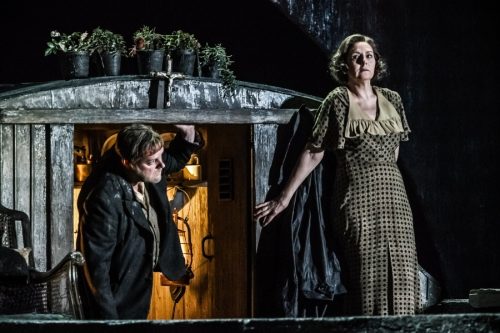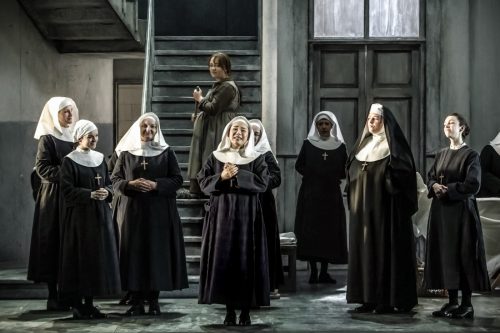David McVicar creates a vividly instant and primarily realist setting for WNO’s new Il trittico – Seen and Heard Worldwide
 United Kingdom Puccini, Il trittico: Soloists, Welsh Nationwide Opera Refrain and Orchestra / Carlo Rizzi (conductor). Wales Millennium Centre, Cardiff, 22.6.2024. (CR)
United Kingdom Puccini, Il trittico: Soloists, Welsh Nationwide Opera Refrain and Orchestra / Carlo Rizzi (conductor). Wales Millennium Centre, Cardiff, 22.6.2024. (CR)

The three operas of Puccini’s ‘triptych’ are in all probability extra typically seen singly or in combos of a pair, relatively than all three collectively in a single night, as supposed by the composer. On the event of the centenary of his loss of life, Welsh Nationwide Opera mount a brand new manufacturing by Sir David McVicar (shared with Scottish Opera) which, for higher or worse, doesn’t utilise any unifying theme or thought throughout all three elements, however merely and efficiently creates a vividly instant and primarily realist setting for every drama.
There may be, nonetheless, a transparent chronological development within the sequence, beginning with Il tabarro in its crepuscular, smoky canalside setting within the again streets of Paris, plausibly round 1910, as within the authentic stage instructions. Claustrophobic as Michele and Giorgetta’s barge is, it nonetheless seems to be a extra inviting habitat than the forbidding, unwelcoming setting on dry land. Suor Angelica presents the inside of a grimly austere convent, with a rickety staircase centre stage, Angelica’s natural workshop to 1 aspect and the chapel on the opposite. An image of Pius XII dates the motion to a particular interval between 1939 and 1958 – if not essentially throughout the Second World Struggle (no reference is made to that) then at the least seemingly throughout the interval of privation after it, which might make extra poignantly ironic the one episode of humour on this opera when Sister Dolcina is teased for her predilection for consuming good issues, at a time when no one had the posh of a full weight loss program. Because the Pope round whom controversy nonetheless circulates as to what extent he didn’t take a bolder stance towards Hitler and Nazism, there’s maybe the concept of ethical compromise, counterpointing that of the heartless remedy of Angelica by her household, and the relatively loveless, unjoyful world witnessed throughout the convent. In a broader emotional sense, the austere setting permits the dramatic level to be made successfully when the golden glow of the setting solar breaks by means of into the convent as a transitory, misinterpreted image of hope. Angelica’s tragedy is echoed by the silent extras of two cleaners, one in all whom is visibly battling some sorrow of her personal and bursts into tears. However one other be aware of humour is launched on stage when Sister Osmina stomps up the steps, like a berated schoolgirl being despatched to her room when she is reprimanded for giving in to her wishes.
Gianni Schicchi strikes on to 1971, as we be taught from the comically fraudulent dictation of Buoso Donati’s different will. That period is colourfully and faithfully recreated in Donati’s chaotically organised chamber with its varied references to Florence, oozing farce and comical mishap even earlier than any strains are sung. As a lot as something, although, it’s the vivacious choreography and performing by the singers which winningly brings this opera to life, with its sharp satire and irony.

Roland Wooden is as sharp witted and poised within the title function of the latter, as he’s pensive and brooding as Michele in Il tabarro; his well-contrasted vocal personas as Schicchi and pretending to be the mortally unwell Donati is a masterclass in musical performing. Alexia Voulgaridou is Michele’s disillusioned spouse Giorgetta, steely and defiant there, whereas within the function of Sister Angelica she expresses vulnerability and disappointment with exemplary management and precision, particularly in a flowing account of ‘Senza mamma’ which avoids sentimentality. Leonardo Caimi sings with unforced lustre as Giorgetta’s paramour, Luigi, whereas Haegee Lee and Oleksiy Palchykov, because the romantic leads in Gianni Schicchi, are delightfully spry, the latter pressing and ringing in his excitable little quantity, and Lee singing with attraction and zeal which makes for a contemporary, relatively than gushing rendition of ‘O mio babbino caro’.
Tichina Vaughn is coldly imperious as The Princess, sweeping in and demanding that her niece, Angelica, signal over her inheritance, with a contact of reedy callousness in her voice, which is softened a bit for her haughty counterpart in Gianni Schicchi, Zita, the mom of Rinuccio who regards Lauretta as unworthy to marry her son, and carrying all of the airs and graces of a Hyacinth Bucket. Different roles are taken as characterfully, particularly in Gianni Schicchi, however there’s an idiomatic conversational alacrity in a lot of the musical dialogue of Suor Angelica, and there are creditable appearances from Daniel Norman, Wojtek Gierlach, and Alison Kettlewell within the smaller roles of Il tabarro, performing as foils to the principle drama.
WNO’s conductor laureate, Carlo Rizzi, leads the performances with instinctive aptitude for the character of every opera’s rating. Regardless of Il tabarro’s darkish set and drama, he attracts from the orchestra a sure luminosity, consistent with music that’s clearly impressed by Debussy, although nonetheless shot by means of with an Italianate lyricism and passion. Suor Angelica sustains a refined stress and drive, regardless of the comparative delicacy of its fully feminine vocal textures. Gianni Schicchi rightly bustles together with fascinating vim, imbued with all of the ebullience of true opera buffa, whether or not that be of the eighteenth century or of Verdi’s Falstaff, to each of which Puccini’s one-act piece is a worthy successor. In my view, the manufacturing is value seeing only for that final opera alone, however the contrasts and shifts in tone and register are compellingly traced in all three elements of this superb triptych.
Curtis Rogers
Featured Picture: WNO’s Gianni Schicchi © Craig Fuller
Il tabarro
Michele – Roland Wooden
Giorgetta – Alexia Voulgaridou
Luigi – Leonardo Caimi
Tinca – Daniel Norman
Talpa – Wojtek Gierlach
La Frugola – Alison Kettlewell
Music vendor – Osian Wyn Bowen
Younger Lovers – Haegee Lee, Oleksiy Palchykov
Suor Angelica
Sister Angelica – Alexia Voulgaridou
The Princess – Tichina Vaughn
Abbess – Sioned Gwen Davies
Sister Genovieffa – Haegee Lee
The Mistress of the Novices – Helen Jarmany
Novice – Alys Roberts
The Sister Monitor – Sophie Yellans
Sister Osmina – Sarah Pope
Sister Docina – Monika Sawa
The Infirmary Sister – Alison Kettlewell
First Alms Sister – Emily Christina Loftus
The Sister Monitor – Sophie Yellans
Second Alms Sister – Angharad Morgan
First Postulant – Claire Hampton
Second Postulant – Beca Davies
Sister Lucilla – Joanne Boag
Allotting Sister – Carolyn Jackson
Gianni Schicchi
Gianni Schicchi – Roland Wooden
Lauretta – Haegee Lee
Zita – Tichina Vaughn
Rinuccio – Oleksiy Palchykov
Gherardo – Daniel Norman
Nella – Fiona Harrison-Wolfe
Betto di Signa – Benjamin Bevan
Simone – Wojtek Gierlach
Marco – James Cleverton
La Ciesca – Sioned Gwen Davies
Maestro Spinelloccio – Julian Boyce
Ser Amantio di Nicolao – Alastair Moore
Pinellino – Stephen Wells
Guccio – Jasey Corridor
Manufacturing:
Director – Sir David McVicar
Revival Director – Greg Eldridge
Set designer – Charles Edwards
Costume designer – Hannah Clark
Lighting designer – Ben Pickersgill
Motion director – Gareth Mole
Battle director – Maisie Carter
Refrain grasp – Frederick Brown
